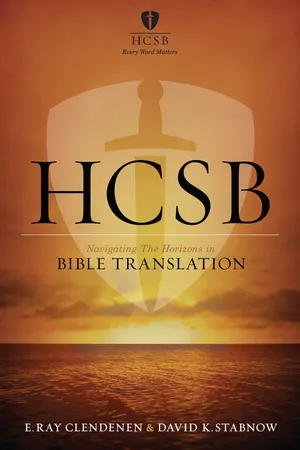
HCSB - Bible Translation
Navigating the Horizons in Bible Translations
- 224 pages
- English
- ePUB (mobile friendly)
- Available on iOS & Android
HCSB - Bible Translation
Navigating the Horizons in Bible Translations
About this book
In Genesis 3: 1 the serpent asked the woman, "Did God really say, 'You can't eat from any tree in the garden'?"What has God really said?Before we can obey Him, we must know what He has said.The Psalmist prayed twice in his affliction, "Give me life through Your word" (Ps 119: 25, 107).When Jesus was afflicted by the Devil in the wilderness (Mt 4: 1-11), He defended Himself with the sword of the Spirit (Eph 6: 17) - God's Word.But Christians must know what God has said if we are to find strength and healing from affliction and defense against the Devil.Bible translation is not a casual enterprise because it involves bringing the life-saving Word of God to people in their own language.And selecting a Bible translation is not on the order of picking out a sweater.It's more like picking a doctor - someone you can trust.This book is about how Bible translation is done.And it commends a particular translation - the Holman Christian Standard Bible (HCSB) - as a trustworthy guide to what God has really said.
Frequently asked questions
- Essential is ideal for learners and professionals who enjoy exploring a wide range of subjects. Access the Essential Library with 800,000+ trusted titles and best-sellers across business, personal growth, and the humanities. Includes unlimited reading time and Standard Read Aloud voice.
- Complete: Perfect for advanced learners and researchers needing full, unrestricted access. Unlock 1.4M+ books across hundreds of subjects, including academic and specialized titles. The Complete Plan also includes advanced features like Premium Read Aloud and Research Assistant.
Please note we cannot support devices running on iOS 13 and Android 7 or earlier. Learn more about using the app.
Information
Table of contents
- Acknowledgments
- Abbreviations
- Introduction: The Birth of a Translation
- English Bible Versions
- What Bible Translators Do
- English Style
- Inclusive Language in Bible Translation
- Issues in Pentateuch and Narrative
- Issues in Poetic and Prophetic Books
- Issues in the New Testament
- Text-Critical Philosophy and Practice
- How Language Works
- Conclusion
- Appendix: Inclusiveness Comparison